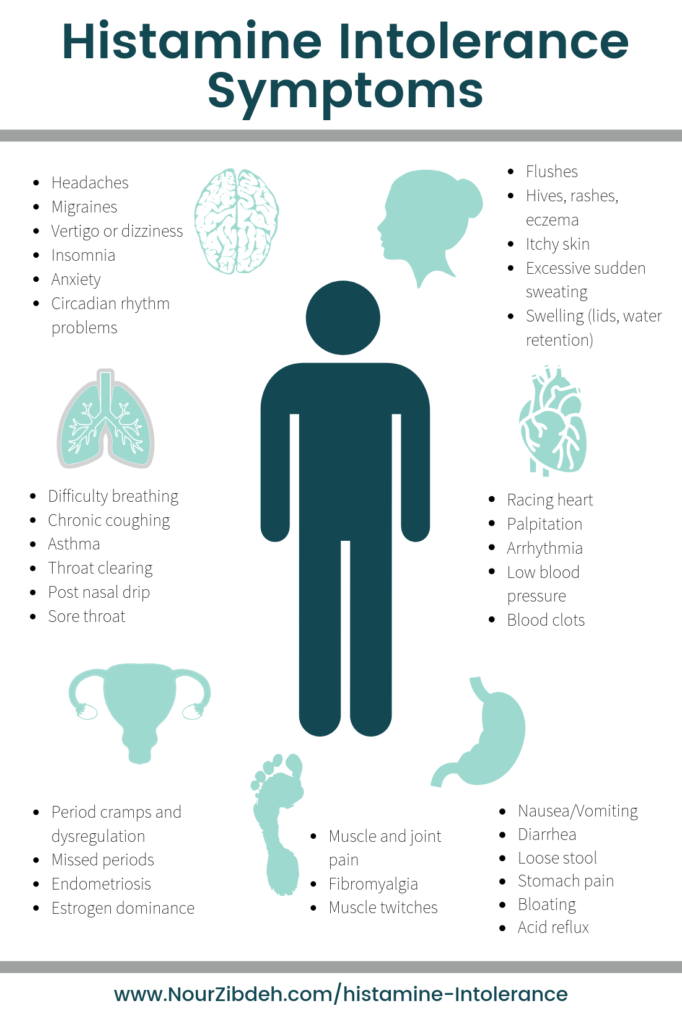Brain fog is a huge pain in the a**. For me, it has been one of THE most significant issues I’ve ever dealt with throughout my life. It always kicks in right after I eat certain foods or supplements and all of a sudden I can’t think straight for a few hours. My brain slows down, my words don’t recall quickly and I lose the motivation to do whatever it is I’m doing. This really adds MORE stress to my life!
Brain fog is real issue and it can be triggered a multitude of things, one of them being an excess of histamine. When histamine becomes and issues this is regarded as a histamine intolerance or toxicity. Learning about this was probably one the best things that ever happened to me in enabling my ability to understand my symptoms and finding solutions. There’s not a lot of providers out there that truly understand this health issue, even functional nutritionist are often in the dark about it. So I’m stoked to dive on in!
What is histamine?
Histamine is a biologically active protein that works on multiple types of cells throughout the body to produce a variety of physiological changes. It has receptors in the brain, the gut, the blood vessels, the lungs, and the skin, thus it can cause a multitude of symptoms. Its main functions are stimulating gastric acid secretion, inflammation, smooth muscle cell contraction, vasodilation and cytokine production, among others. So when this little guy is out of balance it can produce a wide range of symptoms like bloating, to asthma, to hypotension, to hives, and of course brain fog.
Histamine is produced and stored in cells that are triggered to release it when they receive signals from the other cells to do so. These reactions are a product of a multitude of factors such as allergies, stress, eating, infection, and others. Thus histamine issues are often a problem of cellular miscommunication.

How does histamine build up?
Histamine can build up for a number of different reasons. This can be either excessive production of it, excessive intake of it (from food), or poor detoxification of it.
Histamine is produced and stored in cells that are triggered to release it when they receive signals from the other cells to do so. These reactions are a product of a multitude of factors such as allergies, stress, eating, infection, and others. Thus excess histamine production issues are often a problem of cellular miscommunication. In addition, histamine can also be produced by bacteria that live in our gut. Thus when they are out of balance and over populated they can over produce histamine in our gut and cause a lot of gut related symptoms.
Excess histamine intake through food can also cause histamine related symptoms. Food high in histamine can include fermented foods, alcohol, spinach, chocolate, coffee, tea, yogurt, leftovers (cook and eat meat and veggies asap or freeze), broth, tomato, eggplant, peppers, strawberries, citrus, and spices ( cinnamon, turmeric, ginger, chili powder, paprika), pumpkin seeds. Some of these foods have high histamine content as result of the aging process, and some of them have chemicals that trigger histamine release in the body.
Histamine detoxification is often slowed down by either genetic issues that affect the productivity of the enzymes that break down histamine, or nutritional deficiencies that make it harder for the enzymes to work at their optimal capacity. The two main enzymes used in histamine detoxification are DAO and HNMT. DAO is primarily in the small intestine, ascending colon, placenta and kidneys and uses riboflavin (B2) to detoxify histamine. HNMT is primarily in the brain, kidneys and liver, but also the spleen, colon, prostate, ovaries, spinal cord cells, trachea and respiratory tract (PMID: 32824107). It uses methyl groups to detoxify histamine which are little molecules the body produces on its own using predominantly vitamin B12, B9, B6, but also a multitude of other vitamins and minerals.
How do you know if you have a histamine issue?
Histamine can produce a multitude of symptoms depending on where inflammation is most present, and what is causing it. However, the most common are typical allergy symptoms like sneezing, runny nose, congestion, and itchy skin. I also see a lot people with bloating and brain fog that have seen improvements by reducing their histamine burden. However, these can also be produced by other types of inflammatory issues.
So how do you know if these symptoms are really a histamine issue? You will know it’s a histamine issue if foods high in histamine start to produce these symptoms, and if the symptoms resolve when you remove them from your diet. This requires a short term elimination diet over the course of a few days to really assess. Usually the reactions will be right after you eat them, such as sneezing, nose running, itching, or other histamine symptoms.

Can you test for histamine intolerance?
The gold standard is going to be the elimination diet, but you can certainly run a few blood tests like serum histamine. However, serum histamine will only tell you that you’ve got more histamine in your blood than ideal, and not why it’s elevated. Hence why it’s best to also screen for methylation issues or other vitamin deficiencies that are associated with histamine detoxification. Makes like homocysteine can be a good marker for methylation issues and taking a look at the size of your red blood cells using the MCV marker on CBC test can also be helpful.
Functional tests can also be helpful to identify underlying issues behind histamine intolerance:
✅ A comprehensive stool test like the GI Effects, GI Map, or Gut Zoomer could help you identify and fix an overgrowth of histamine producing bacteria
✅ A food sensitivity test like the IgG Food Explorer could help you identify foods that cause inflammation in your body
✅ A nutritional test like the Nutreval or another organic acids test could help you resolve nutritional deficiencies and optimize methylation.
What supplements can you take to help with histamine intolerance?
There’s a lot of products out there on the market these days that are touted for being helpful at reducing histamine. In general, you can take supplements to improve the detoxification of it and also to reduce the production of it. For example, you can supplement with DAO enzymes directly with your food to help in the break down. For this one I use Histamine Block by Seeking Health. I prefer to add in formulas containing b vitamins and minerals that help the enzymes that break down histamine as well. One of my favorites here is Hist-Reset by Pure Encapsulations. A lot of these formulas use herbs like luteolin and quercetin which are touted for being able to reduce the release of histamine from cells that produce it.
Takeaways
Overall, many annoying symptoms triggered by foods can be a histamine intolerance. Brain fog is only one of many different manifestations of this annoying predicament. Being able to identify it and understand its impacts on your body is the most important step. Once you know where it’s coming from you can start to take steps to reduce your histamine burden. Thankfully we have a lot of resources now that can further assist with the histamine burden such as supplements and testing that can assist with this whole process. Taking your health into your own hands is crucial. Whether it is a full on gut restoration protocol, detox, or simple dietary shifts, you can get your life back and stop dealing with these annoying symptoms.






No responses yet